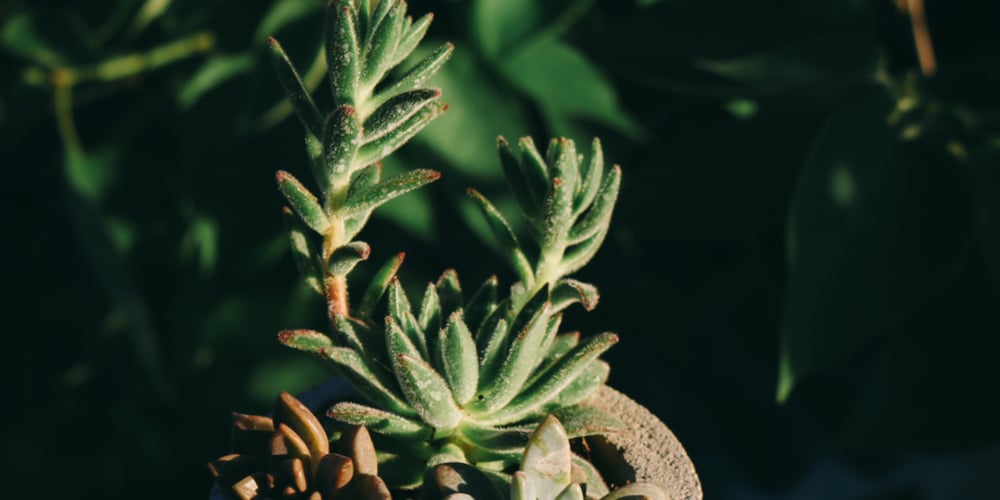A hybrid cross between echeveria and graptopetalum, the ‘Olivia’ is a very low-maintenance houseplant with equally attractive leaves and flowering stalks.
| Botanical Name | Echeveria ‘Olivia’ |
| Common Name | Graptoveria Olivia |
| Plant Type | Perennial |
| Flower Color | Small, star-shaped yellow blooms |
| Size When Mature | 5 inches |
| Bloom Time | Early Spring to Late Summer |
| Sun Requirements | Full Sun to Partial Shade |
| USDA Hardiness Zones | 9 to 11 |
| Soil PH Range | 5.0 to 7.0 |
| Soil Type | Loose and well-draining |
| Water Needs | Very low |
| Native Area | South Africa |
What you Need to Know About Graptoveria Olivia
Graptoveria Olivia is a hybrid succulent that has a rosette pattern and olive green leaves. Depending on the amount of light it gets, the thick leaves can turn a lighter or darker shade as well as a pink or red tinge.
As a succulent, ‘Olivia’ is very easy to care for and grows slowly. The plant sometimes sends up tall stalks that form a starry-shaped yellow flower. Bloom time can occur from spring through summer. Graptoveria Olivia grows well in both outdoor and indoor settings and requires very little watering.
How to Care for Graptoveria Olivia
Here’s everything you need to know about growing and caring for a thriving Graptoveria Olivia
Light
Graptoveria ‘Olivia’ does best in a spot that gets bright light. The slow-growing succulent does not need to be exposed to full sunlight and may change its leaf color as a result. An hour or two of direct sun should be fine, but anywhere that’s shaded and bright will be great. Place your ‘Olivia’ graptoveria on a windowsill and it will stay there happily for years.
This graptoveria variety adapts to shade but will not have the pink flush on its foliage. As a houseplant, you’ll need to provide around 4 to 8 hours of natural light and rotate it every week for even growth.
Water and Soil Needs
Succulents, in general, are not picky about the type of soil they’re in, and ‘Olivia’ graptoveria is no exception. In its native region of South Africa, they sit on rocky and dry soil for weeks at a time.
A succulent or cactus mix bought from any garden store or nursery should suffice for your ‘Olivia’ plant. If you’re mixing your own, make sure that the soil is freely draining and does not hold moisture for a long time.
Graptoveria ‘Olivia’ does not need too much water. Only reach for the watering can when the top of the soil is dry to the touch and the leaves are looking a bit wrinkly. It’s recommended that you water only once in a bi-weekly schedule or more when the weather is hot.
Temperature Requirements
‘Olivia’ is hardy in zones 9 to 11 and can tolerate an environment that gets full sun. On the other hand, the succulent will not survive a hard frost and temperatures that fall below 32 degrees F (or 0 degrees C).
Fertilizer
The best fertilizer to use on a Graptoveria Olivia is a well-balanced fertilizer given at half strength.
Graptoverias are similar to echeverias and graptopetalum in that they can grow in a medium that doesn’t have a lot of nutrients. While these plants will welcome any feeding given to them, ‘Olivia’ won’t demand that you do so.
Fertilizer at half strength means you should halve the dosage as stated by the manufacturer on the label or packaging. This can be done in its growing season. Otherwise, your ‘Olivia’ will be satisfied with just sunlight and the occasional watering.
Common Diseases
Succulents, including the Graptoveria Olivia, are tough and largely unaffected by pests and diseases. However, root rot and black rot can affect your Olivia succulent and usually presents themselves if you overwater them.
Waterlogged soil will lead to excessive moisture where fungus can thrive. This can be remedied by holding off on the watering and following a twice-a-month schedule.
Graptoveria Olivia Propagation
Graptopveria ‘Olivia’ may be propagated by leaf cuttings or dividing the offsets. Small rosettes on the sides are called ‘offsets’ or basically baby versions of their parents. These can be gently removed from the mother plant and grown in a separate container.
Alternatively, you can remove a healthy-looking and plump leaf and grow a new succulent plant from it. Allow it to dry out for two to three days, then set the fleshy end in a succulent potting mix. Spray the soil every three to five days and soon, baby rosettes and roots will grow out of them.
After the leaves have sprouted small Olivia plants, repot them in the same mix as your parent plant, and set the succulents in a place that gets bright light.
Related article: Graptoveria Lovely Rose

